SS Cameronia Archival Collection
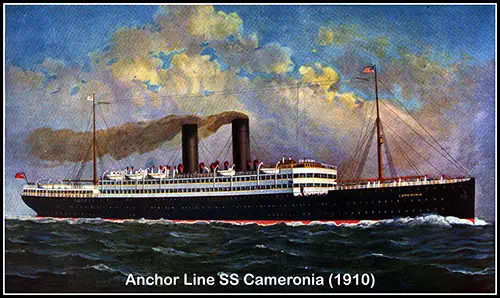
SS Cameronia (1910) of the Anchor Steamship Line. History of the Anchor Line, 1911. | GGA Image ID # 1d26fbbdbb
Content Links
- Cameronia (1910) Anchor Line
- Cameronia (1920) Anchor Line
- Passenger Lists
- Brochures
- Menus
- Route Maps, Track Charts, Abstract of Logs
- Other Ephemera
- Passage Rates
- Services
- Sailing Schedules
- Fleet List
- Photographs
- Advertisements
- Stationery
- Books Referencing the SS Cameronia
- The Anchor Liner Cameronia - 1921
Cameronia (1910) Anchor Line
Built by D. & W. Henderson & Co., Glasgow, Scotland. Tonnage: 10,963. Dimensions: 515' x 62' (532' o.l.). Propulsion: Twin-screw, 17 knots. Triple expansion engines. Masts and Funnels: Two masts and two funnels. Passengers: 250 first, 450 second, 1,000 third. Maiden voyage: Glasgow-New York, September 9, 1911. WW1 Service: Converted to troopship in 1917. Fate: Torpedoed and sunk without warning 150 miles from Malta, April 15, 1917, with the loss of a number of lives. Running mates: Caledonia, California, and Columbia. Note: None were identical.
Cameronia (1920) Anchor Line
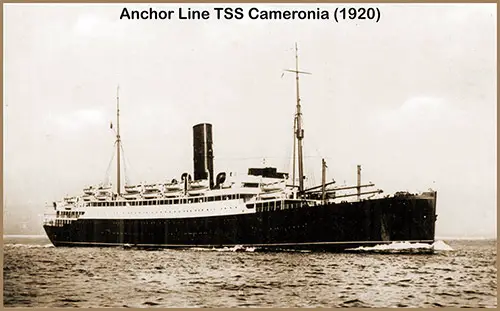
Picture Postcard of the SS Cameronia (1920) of the Anchor Line. | GGA Image ID # 1db3bde4a0
Built by Wm. Beard more & Co., Glasgow, Scotland. Tonnage: 16,297. Dimensions: 552' x 70' (575' o.l.). Twin-screw, 15 1/2 knots. Steam turbines. Two masts and one funnel. Launched: December 23, 1919. Maiden voyage: Liverpool to New York in May 1921. Carried a total of 186,770 passengers from time she commenced maiden voyage to August 1939. WW2 Service: Served as a troopship in World War II. Torpedoed by aircraft in December 1942, but was able to make port. Reconditioned for the Australian immigrant service in 1948. Renamed: Empire Clyde (1953). Fate: Broken up by British shipbreakers in 1958. Note: Similar in appearance to Lancastria of Cunard Line.
Return to Content Links
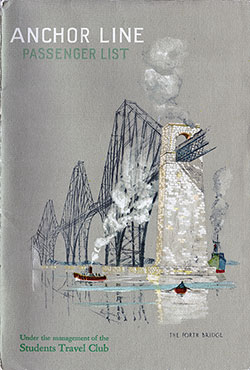
SS Cameronia Passenger Lists 1913-1933
All Digitized Lists of Passengers for the SS Cameronia Available at the GG Archives. Listing Includes Date Voyage Began, Steamship Line, Vessel, Passenger Class and Route.
Routes: Glasgow to New York via Moville; Glasgow for New York via Moville, Liverpool, Queenstown (Cobh), and Halifax NS; and New York to Londonderry and Glasgow via Boston.
Return to Content Links

1911 - Anchor Line Special Attractions For the Excursion Season
This brochure printed by the Anchor Line for the Tourist season in 1911 featured information for passengers, internal and external photographs of the ships and interior views and some information on destinations. Ships Covered: Caledonia, California, Cameronia, and Columbia.

1912 - Anchor Line Information For Passengers
Exquisite brochure from 1912 offers an excellent glimpse of cabin class travel aboard steamships of that era. This booklet was produced after the Anchor Line's Newest steamship - The Cameronia in 1911. Other Ships Covered: Caledonia, California, and Columbia.

1913-11-29 Anchor Line Second Cabin Accommodations - 1913
12-Page brochure on second cabin accommodations on transatlantic steamships of the Anchor Line offering weekly service between New York, Glasgow, and Londonderry. Published by Amsden-Kalbfleisch Co., Agents - Rochester, NY on 29 November 1913. Numerous photographs, Rates of Passage, and other information are included. Ships Covered: Caledonia, California, Cameronia, and Columbia.

Going Abroad via Cunard and Anchor Lines - 1923
Excellent brochure from 1923 provides numerous photographs, the majority interior views of the many steamships in the fleets of the Cunard and Anchor Lines. Ships covered include Albania, Aquitania, Assyria, Berengaria, Cameronia, Carmania, Caronia, Columbia, Franconia, Laconia, Mauretania, Samaria, Saxonia, Scythia, Tuscania, Tyrrhenia, and "A" Class Ships. Additional features included Cold Buffets, Assorted Staterooms, and a large format Map of "Strange Lands and Foreign Ports Reached by Cunard and Anchor Passenger Services."

1926 - The New Anchor Line Fleet
Profusely illustrated brochure from 1926 documents the grand interiors of the Caledonia and Transylvania, the newest additions to the Anchor Line fleet with views of the California and Cameronia, transporting passengers between New York, Londonderry, and Glasgow. Ships Covered: Antonia, Ascania, Caledonia, California, Cameronia, Transylvania, and Tuscania.
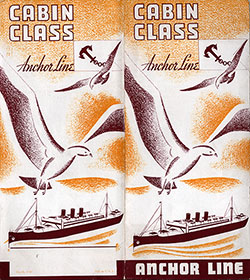
1930s - Anchor Line Cabin Class
For passengers who are accustomed to the amenities of good-living, the Anchor Line offers a truly delightful mode of travel, in the company of other passengers with the same substantial standards which characterize their own good taste. Ships Featured: Caledonia, California, Cameronia, and Transylvania.
Return to Content Links
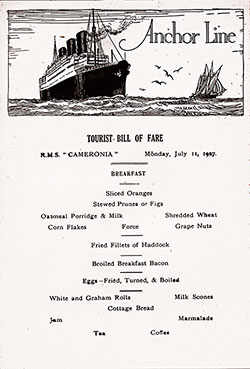
RMS Cameronia Vintage Menu Collection
Vintage menus for the RMS Cameronia in the GG Archives collection includes souvenir breakfast menus provided to the passengers during their voyage.
Return to Content Links
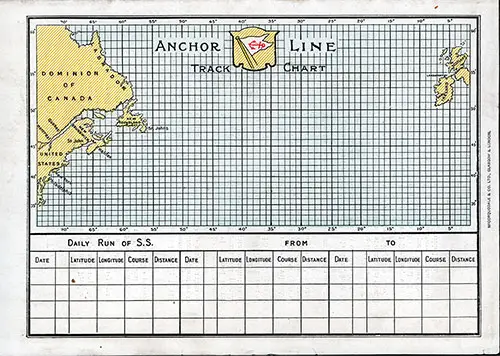
Unused Anchor Line Track Chart and Memorandum of Log from 1913. | GGA Image ID # 1db3b4ae0f
Return to Content Links
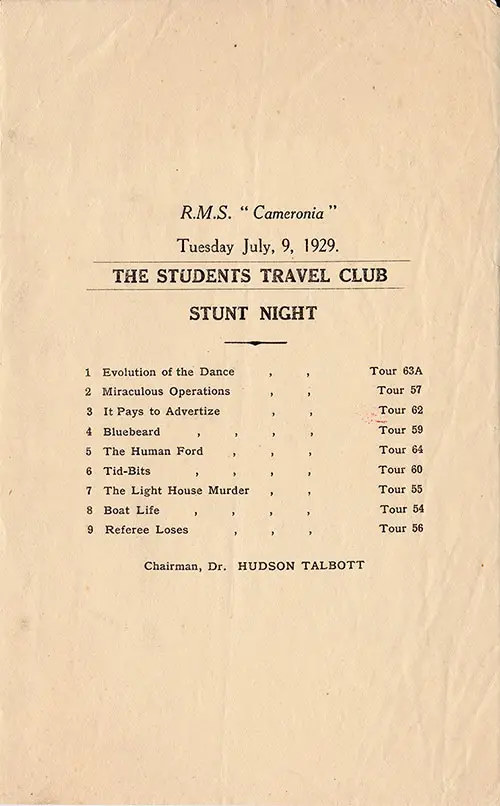
Stunt Night - Student Travel Club, 9 July 1929 on board the RMS Cameronia. | GGA Image ID # 172fd40e7e
Return to Content Links
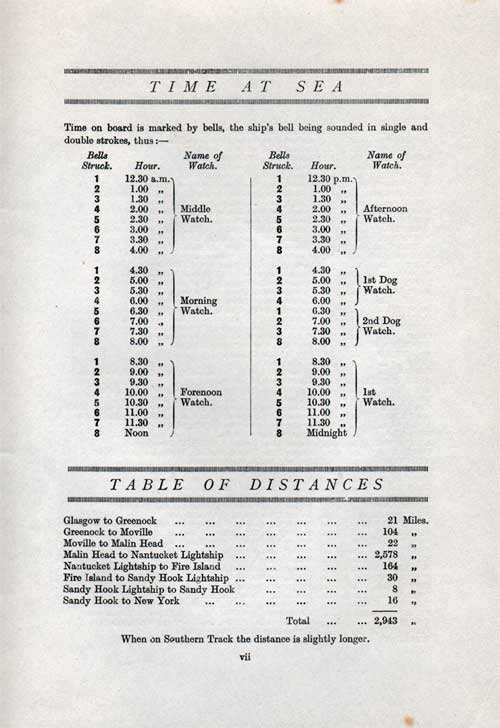
Time at Sea and Table of Distances. RMS Cameronia Passenger List, 31 July 1926. | GGA Image ID # 1e3f823dad
Return to Content Links
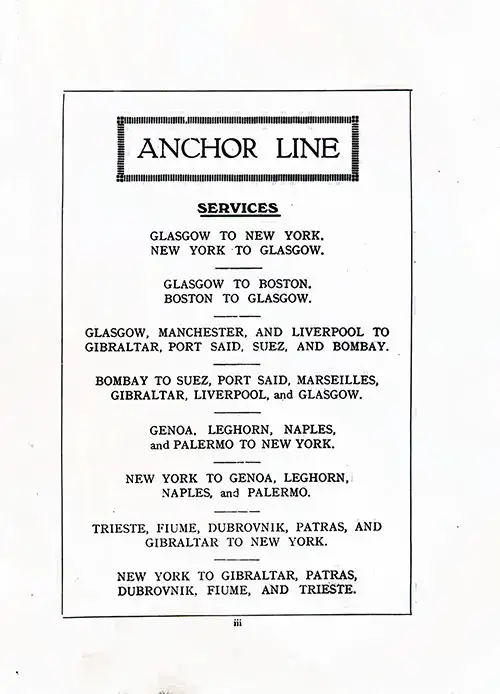
Global Services of the Anchor Steamship Line, 1922. RMS Cameronia Passenger List, 24 February 1922. | GGA Image ID # 1e3f331f88
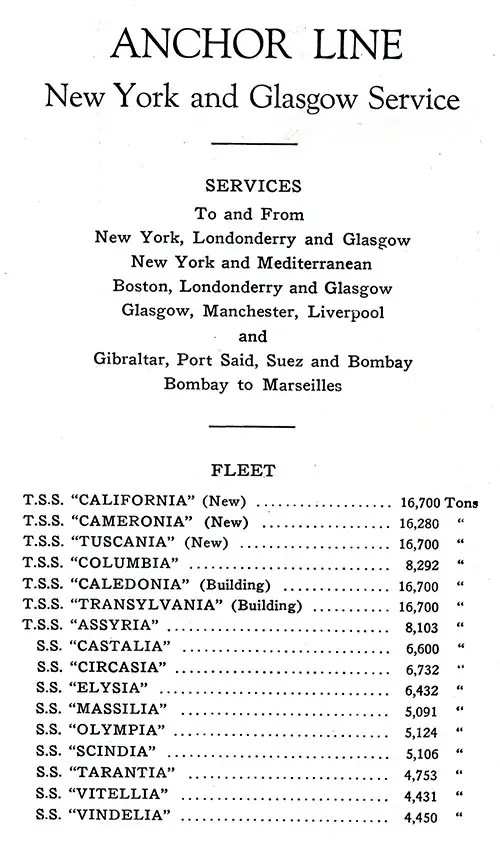
Anchor Line New York and Glasgow Services; Fleet List. SS Cameronia Saloon and Second Class Passenger List, 5 July 1924. | GGA Image ID # 21708a99fb
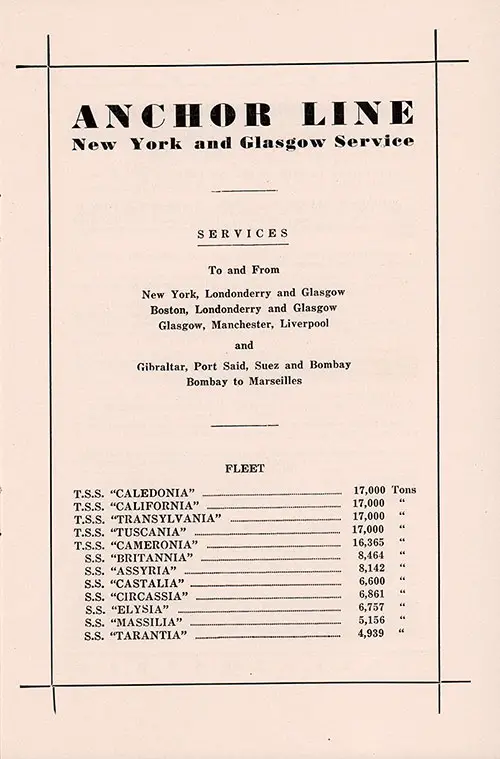
Anchor Steamship Line Services and Fleet, 1932. TSS Cameronia Passenger List, 25 June 1932. | GGA Image ID # 1e3fba6146
Return to Content Links
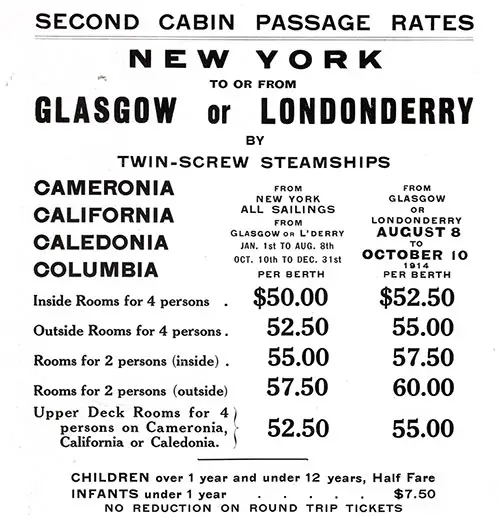
Anchor Line Second Cabin Passage Rates In Effect 1913. Ships Included the Caledonia, California, Cameronia, and Columbia. Second Cabin Accommodations Brochure, 1913. | GGA Image ID # 1156df9815
Return to Content Links
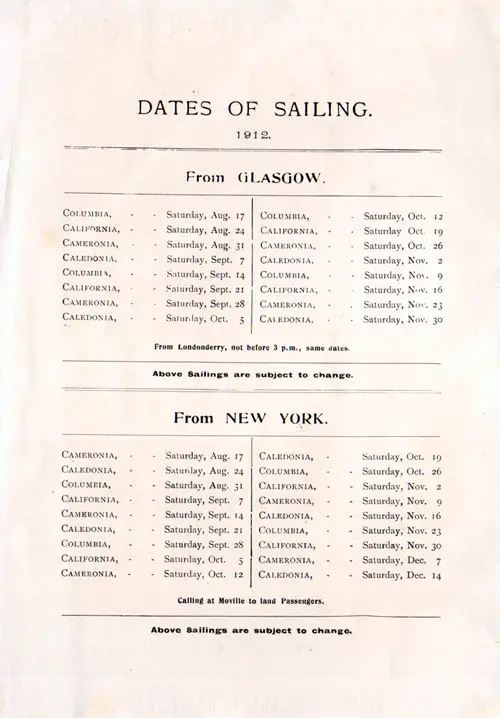
Sailing Schedule, Glasgow-New York, from 17 August 1912 to 14 December 1912. Ships included the Caledonia, California, Cameronia, and Columbia. SS Columbia Passenger List, 17 August 1912. | GGA Image ID # 1e3b7feb7b
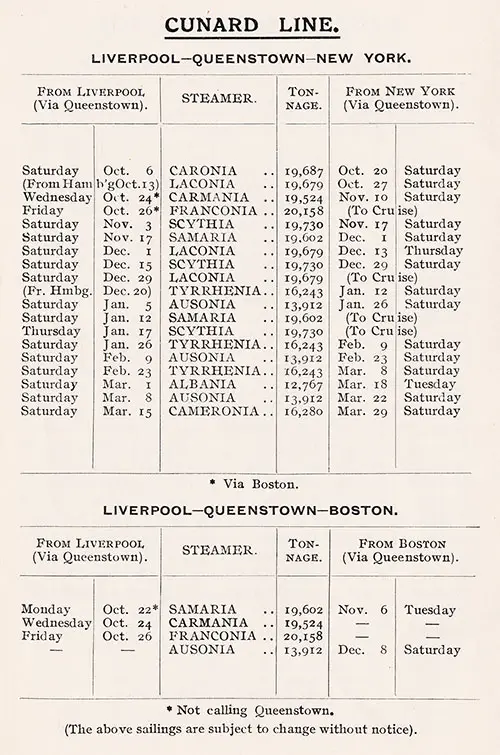
Sailing Schedule, Liverpool-Queenstown (Cobh)-New York and Liverpool-Queenstown (Cobh)-Boston, from 6 October 1923 to 29 March 1924. Ships Included the Albania, Ausonia, Cameronia, Carmania, Caronia, Franconia, Laconia, Samaria, Scythia, and Tyrrhenia. RMS Samaria Passenger List, 22 October 1923. | GGA Image ID # 1f18c82ce2
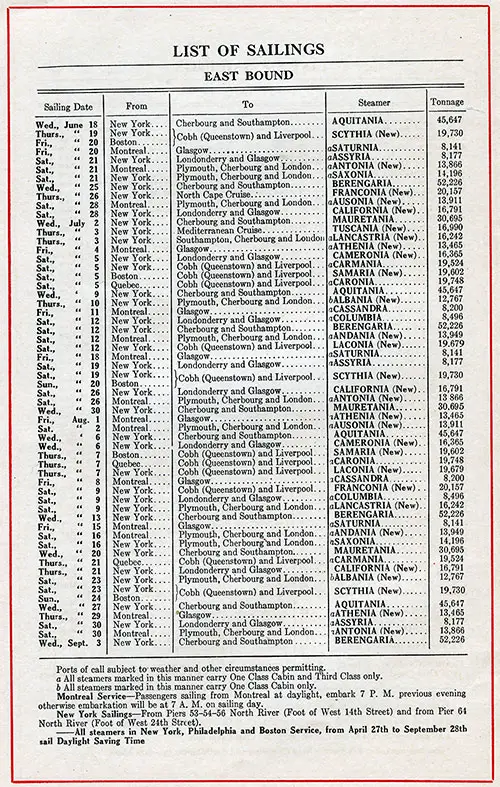
Eastbound Sailing Schedule from the US and Canadian Ports to European Ports, from 18 June 1924 to 3 September 1924. Ships Included the Albania, Andania, Antonia, Aquitania, Assyria, Athenia, Ausonia, Berengaria, California, Cameronia, Carmania, Caronia, Cassandra, Columbia, Franconia, Laconia, Lancastria, Mauretania, Samaria, Saturnia, Saxonia, Scythia, and Tuscania. RMS Aquitania Second Class Passenger List, 18 June 1924. | GGA Image ID # 20aea275f3
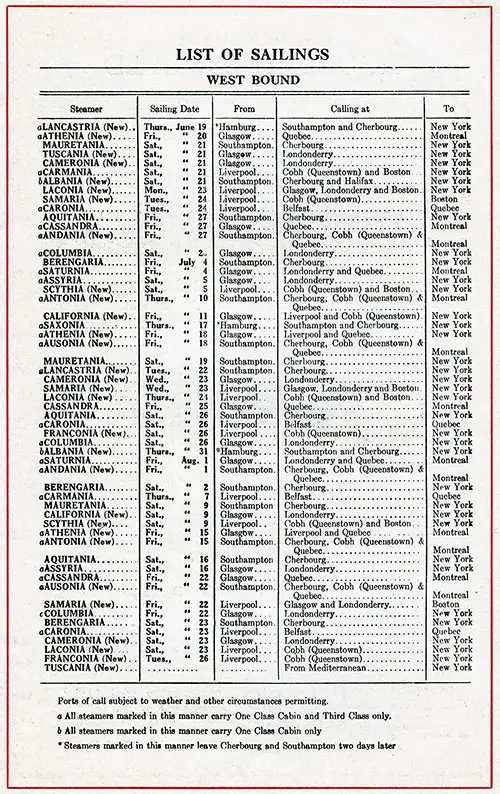
Westbound Sailing Schedule, from European Ports to Canadian and US Ports, from 19 June 1924 to 26 August 1924. Ships Included the Albania, Andania, Antonia, Aquitania, Assyria, Athenia, Ausonia, Berengaria, California, Cameronia, Carmania, Caronia, Cassandra, Columbia, Franconia, Laconia, Lancastria, Mauretania, Samaria, Saturnia, Saxonia, Scythia, and Tuscania. RMS Aquitania Second Class Passenger List, 18 June 1924. | GGA Image ID # 20aeac371f
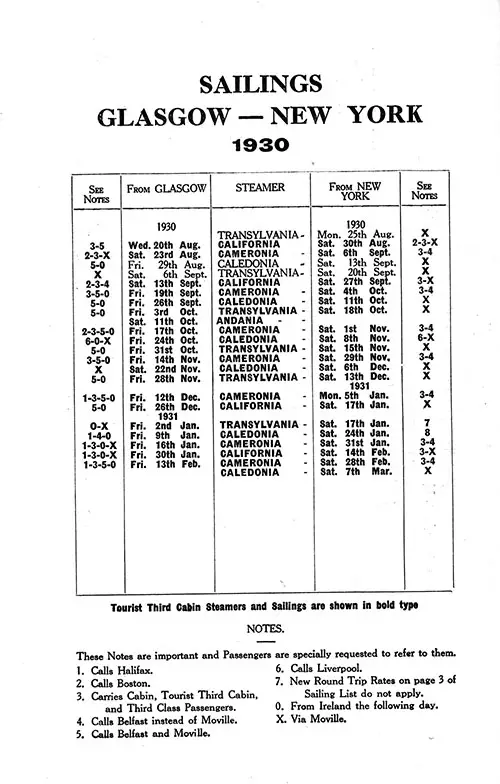
Sailing Schedule, Glasgow-New York, from 25 August 1930 to 13 February 1931. Ships Included the Andania, Caledonia, California, Cameronia, and Transylvania. SS California Passenger List, 20 August 1930. | GGA Image ID # 1e39b3e994
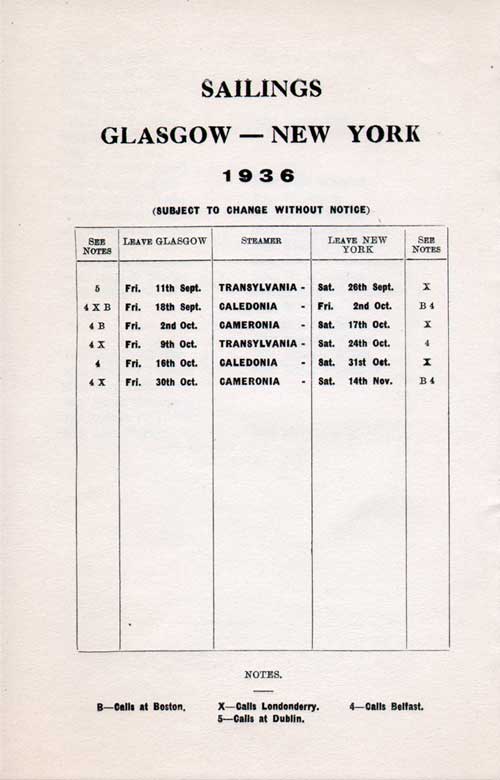
Sailing Schedule, Glasgow-New York, from 11 September 1936 to 14 November 1936. Ships Included the Caledonia, Cameronia, and Transylvania. SS Transylvania Passenger List, 11 September 1936. | GGA Image ID # 1e3ad41e77
Return to Content Links
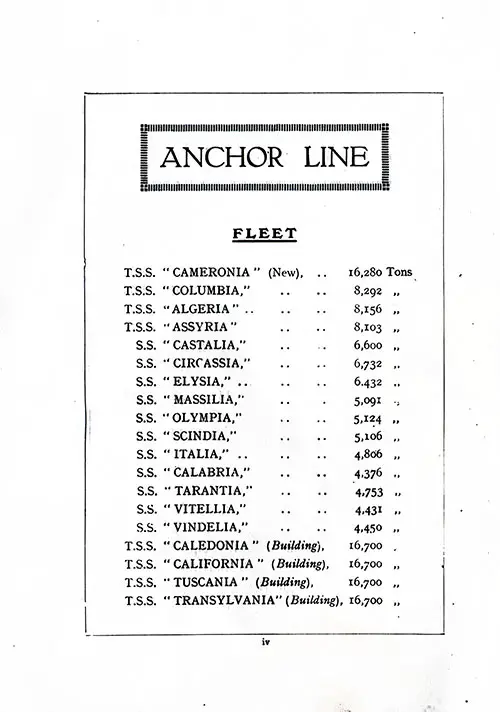
Anchor Line Fleet List, 1922. RMS Cameronia Passenger List, 24 February 1922. | GGA Image ID # 1e3f28649c
Return to Content Links
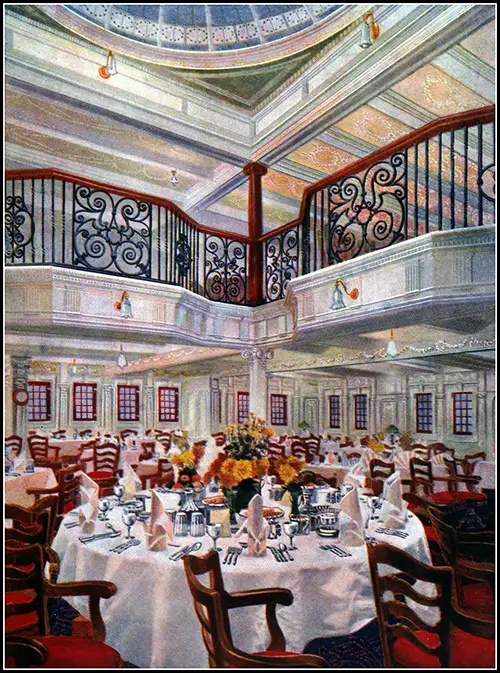
First Class Dining Saloon and Music Room on the SS Cameronia (1910) of the Anchor Steamship Line. History of the Anchor Line, 1911. | GGA Image ID # 1d2742ed5a
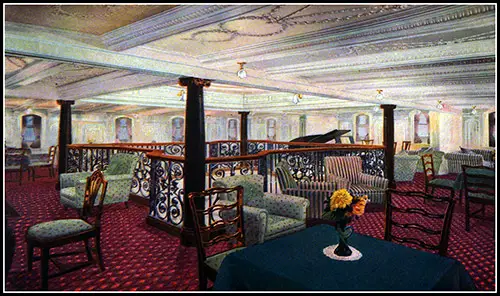
SS Cameronia (1910) First Class Music Room. History of the Anchor Line, 1911. | GGA Image ID # 1d27af930f
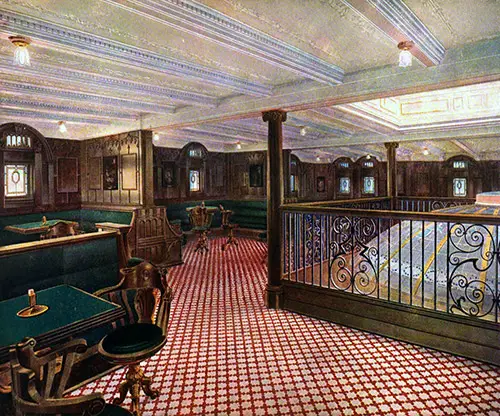
SS Cameronia (1910) First Class Smoking Room. History of the Anchor Line, 1911. | GGA Image ID # 1d27be32ac
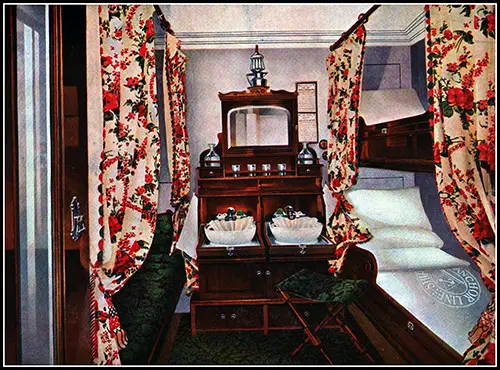
SS Cameronia (1910) First Class Stateroom. History of the Anchor Line, 1911. | GGA Image ID # 1d28343cad
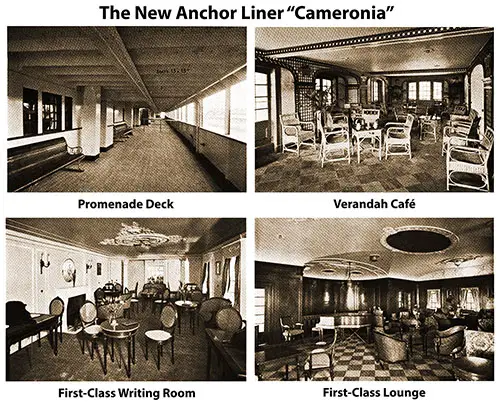
First-Class Public Areas on the Anchor Line SS Cameronia (1920). Clockwise: Promenade Deck, Verandah Café, First-Class Writing Room, and the First-Class Lounge. Shipbuilding and Shipping Record, 9 June 1921. | GGA Image ID # 1db3bffc63
Situated at the head of the main stairway, the first-class lounge is a magnificent room and much loftier than usual. It is worked out on French renaissance lines, paneled in warm-toned oak with richly carved moldings and ornaments.
The barrel-vaulted ceiling is richly ornamented, and a large oval painting occupies the center. The furniture and richly carpeted floor blend harmoniously with the fittings and produce a feeling of warmth and comfort. The open floor area of this room, and its unusual height, make it an admirable room for dancing.
The first-class dining saloon's decoration is in the Italian Renaissance style. The portholes are grouped in pairs under semi-circular arches resting on small columns alternately straight and spirally fluted—reminiscent of the arcades in the old Italian palaces at Florence and elsewhere.
In the center of the room, an interesting architectural feature has been introduced. Here the room has been carried up 16 ft. high, and the walls are treated like an interior courtyard, with projecting balconies having wrought-iron fronts of exciting design.
From these balconies, one can look down into the saloon below. The walls of the saloon are toned ivory white with rich grey panels. The ceiling is of ivory-toned plasterwork, and the draperies are purple embroidered with old gold.
The first-class writing room is a quiet apartment opening off the entrance vestibule. In style, it follows the work of the Louis XVI period. The plaster ceiling, with its delicate enrichments, is slightly coved, giving an effect of lightness.
The interest in the wall space is enhanced by several carefully selected pictures of the period. The room is suitably furnished with writing tables and comfortable chairs covered in rich tapestries.
In the first-class verandah café, the appearance of an old garden has been aimed. The walls are treated to represent stone with trellis decoration, and a marble fountain adorns the center. The furniture consists of cane chairs and tables, and rugs of Oriental design enhance the appearance of the polished floors.
The general decoration scheme in the first-class smoke room is early Italian renaissance, worked out in stone plaster and paneling in Italian walnut. An interesting vault is in the center of the room, supported by rich, warm-toned marble columns.
Pierced openings filled with wrought-iron grilles of chaste design admit light to this vault, and stags' heads on either side of these openings give a charming touch to this room. Leather-covered furniture designed on broad lines gives an appearance of solid comfort.
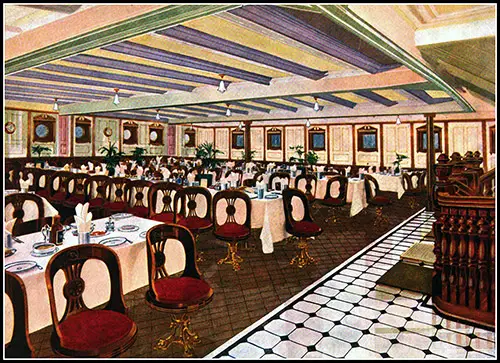
SS Cameronia (1910) Second Class Dining Saloon. History of the Anchor Line, 1911. | GGA Image ID # 1d285d75a2
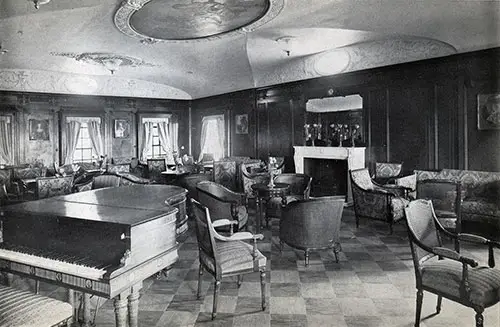
General Lounge of the SS Cameronia (1920). | GGA Image ID # 115ba74ec0
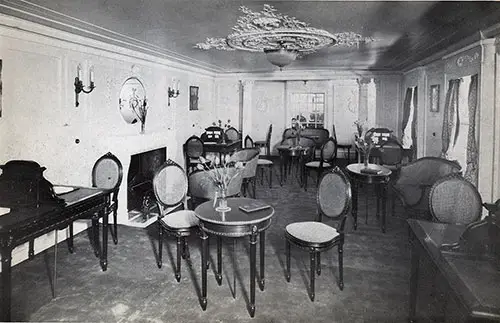
Writing Room of the SS Cameronia (1920). | GGA Image ID # 115beb65d7
The second-class dining saloon is decorated in the period of the French renaissance. The large panels separating the port holes give an atmosphere of dignity and repose. In the center of the room, the dome is supported by graceful columns. The color scheme of the room is cream and grey. In the second-class lounge, the ceiling is painted ivory white, and the general color scheme of the room is carried out in light subdued tones. The furniture is handsome and comfortable in the Louis XVI style, and the polished floor is heavily carpeted.
Plants are artistically disposed about the room. The whole produces that sense of restfulness that is essential in a lounge. The second-class smoke room, furnished with fawn-brown leather-covered settees and easy chairs, offers comfort and ease for the smoker. Well-chosen pictures adorn the walls, paneled in a simple but pleasing manner. Oriental rugs relieve the polished surface of the floor.
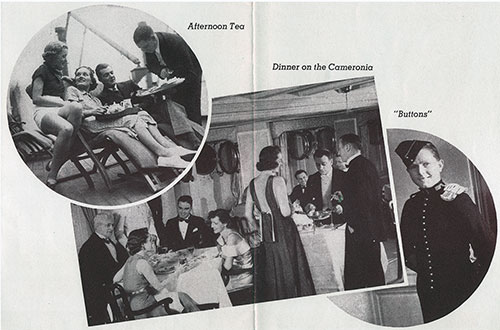
Left to Right: Afternoon Tea; Dinner on the Cameronia (1920); and "Buttons." GGA Image ID # 115eee6355
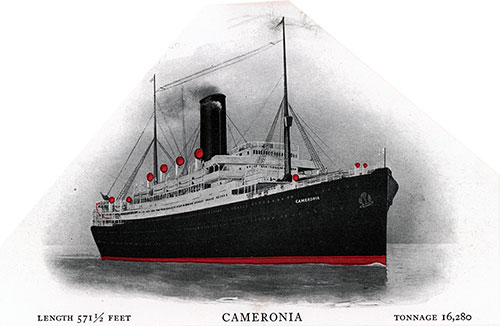
The Cunard-Anchor Ship RMS Cameronia. Length 571 1/2 Feet; Tonnage: 16,280. Going Abroad, 1923. | GGA Image ID # 1bcaf93af4
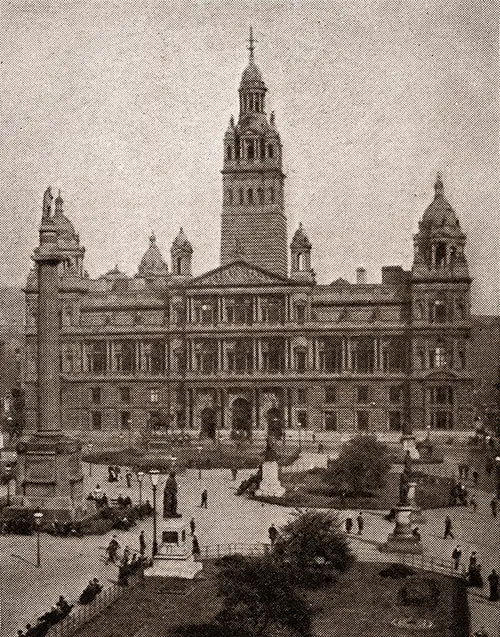
Glasgow, the Largest City in Scotland, Is a Place of Contrasts. A Mediaeval Cathedral, a University, and Great Steel-Ship Foundries Vie with Each Other in Interest. The Cameronia Was the First Oil-Burner to Make the Trip between Glasgow and New York. Going Abroad, 1923. | GGA Image ID # 1bcb0b8647
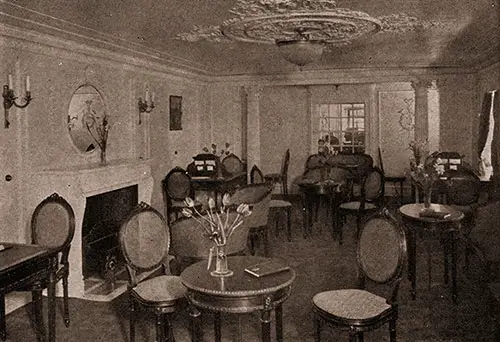
The Delicate Loveliness of Louis XVI's Court Inspired the Charm of The Cameronia Writing-Room. The Wall Sconces, the Rich Draperies, Tapestried Chairs, and the Period Pictures on the Tinted Walls Make It Perfect. Going Abroad, 1923. | GGA Image ID # 1bcb2c840d
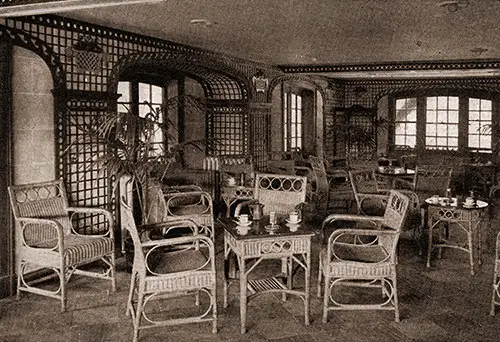
"Come into the Garden, Maud," Might Have Been Whispered from the Trellised Arch of the Veranda Café on the Cameronia, so like a Picturesque Old Garden Is Its Atmosphere. There Is Even a Beautiful Marble Fountain in the Center. Going Abroad, 1923. | GGA Image ID # 1bcb6e462a
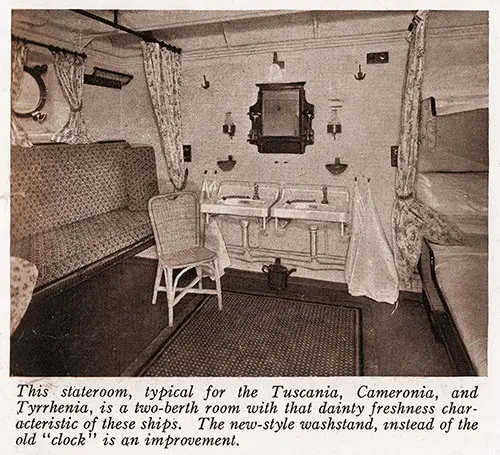
This Stateroom, Typical for the Tuscania, Cameronia, and Tyrrhenia, Is a Two-Berth Room with That Dainty Freshness Characteristic of These Ships. The New-Style Washstand, Instead of the Old "Clock," Is an Improvement. Going Abroad, 1923. | GGA Image ID # 1bd238bb95
Return to Content Links
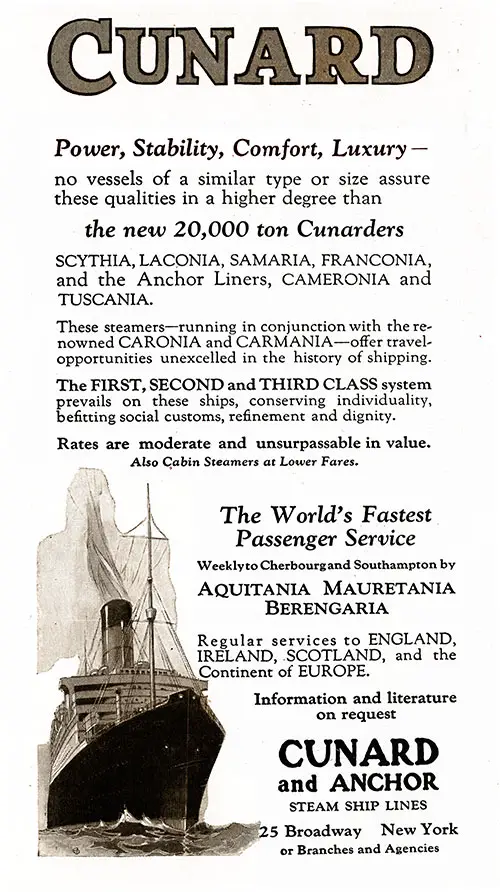
Advertisement: Cunard Anchor Lines, Power, Stability, Comfort, Luxury in 1923 -- The New 20,000 Ton Cunarders Scythia, Laconia, Samaria, Franconia, and the Anchor Liners Cameronia and Tuscania. These Steamers--Running in Conjuction with the Renowned Caronia and Carmania--Offer Travel Opportunites Unexcelled in the History of Shipping. The World's Fastest Passenger Service, Weekly to Cherbourg and Southampton by the Aquitania, Mauretania, and Berengaria. Ocean Records, May 1923. | GGA Image ID # 1e687406f0
Return to Content Links
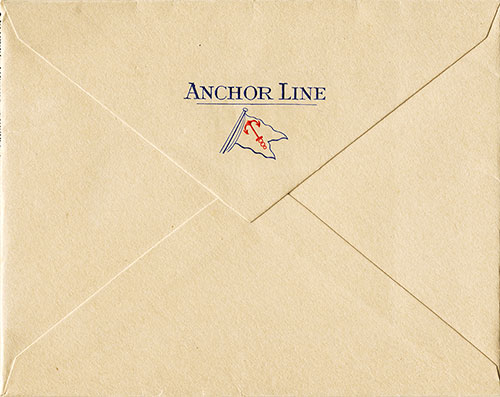
Anchor Line Stationery: Envelope, SS Cameronia Saloon and Second Class Passenger List, 5 July 1924. | GGA Image ID # 2170b76d33
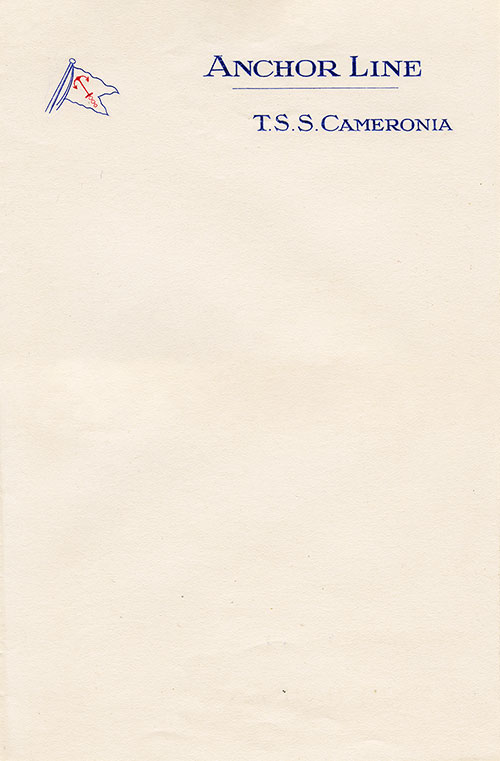
Anchor Line TSS Cameronia Stationery: Letterhead, SS Cameronia Saloon and Second Class Passenger List, 5 July 1924. | GGA Image ID # 2170f2ff1a
Return to Content Links

A Century of Sea Travel: Personal Accounts from the Steamship Era
This book is a voyage through the life of the passenger steamship, a voyage described by travellers who sailed on these vessels, and it carries within it their thoughts and experiences, mirrored here in words and pictures.
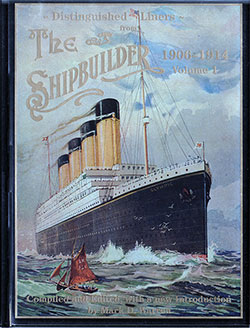
Distinguished Liners from The Shipbuilder - 1906-1914 Volume 1
An authentic replication to the smallest detail of the best of The Shipbuilder magazine, 1906-1914, including articles on the Titanic, Olympic, Lusitania, Mauretania, and more. This encyclopedic collection contains original text, photographs, and advertisements, as well as 22 fold-out blueprint plans, five color plates, a two-color Titanic cutaway folding advertisement and even two facsimile subscription forms.

Great Passenger Ships of the World 1858-1912
This initial volume deals with Ships from 1858-1912, from the first passenger ship of over 10,000 GRT to be placed in service (the Great Eastern) to those unforgettable sister ships, the Olympic and Titanic — the first of more than 40,000 GRT.
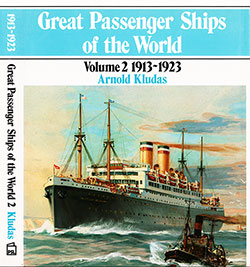
Great Passenger Ships of the World 1913-1923
The period 1913-1923 is dealt with in this second volume. Although it was only a decade, it was one of the most turbulent passenger ships in history. Competition to produce ever-larger vessels declined between leading North Atlantic shipping companies. For 20 years, the ships of the Imperator Class were the largest in the world.

Liverpool and the Mersey, Vol. 1: Gladstone Dock and the Great Liners
More than 190 rare archive photographs and maps, many never before published, recount the story of this most famous dock and the Great passenger Ships that were once a regular sight there.

Ocean Steamers: A History of Ocean-Going Passenger Steamships 1820-1970
A history of the steam-powered passenger ship that details its story from the SS Savannah of 1819 to the SS Hamburg of 1969. It contains historical details of all civilian vessels built in the intervening years, with numerous illustrations and previously unpublished material.
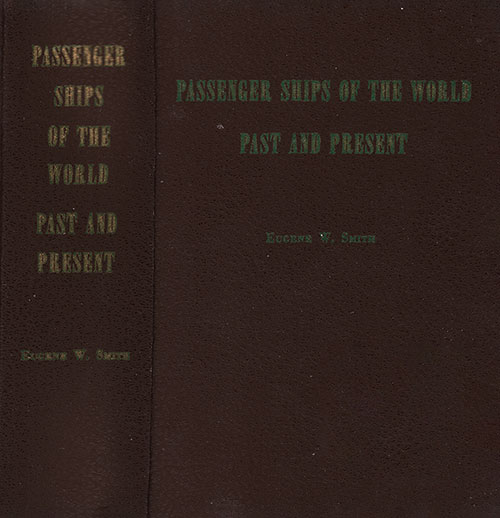
Passenger Ships of the World - 1963
🎓 “A Global Voyage Through Steamship History for Historians, Genealogists, and Maritime Enthusiasts”
Eugene W. Smith’s Passenger Ships of the World – Past and Present (1963) is a masterfully curated encyclopedic reference that charts the rise, peak, and transformation of ocean-going passenger ships through nearly two centuries. Expanding upon his earlier Trans-Atlantic and Trans-Pacific works, Smith offers a global maritime panorama that includes ships serving the Americas, Africa, Europe, Asia, Australia, and Oceania, as well as Canal routes and California-Hawaii shuttle lines.
🧭 This book is an essential resource for:
- Maritime historians seeking design evolution and fleet data
- Genealogists tracing voyages and shipping lines
- Educators and students studying transoceanic migration and tourism
- Ship modelers, naval architects, and enthusiasts interested in dimensions, tonnage, and speed

Pictorial Encyclopedia of Ocean Liners, 1860-1994
One of the most comprehensive pictorial references on ocean liners ever published, this superb chronicle by noted maritime historian William H. Miller, Jr., depicts and describes virtually every passenger ship of over 15,000 tons built between 1860 and the late 1900s.
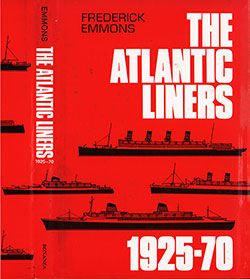
THE ATLANTIC LINERS will be cherished by all the millions of Americans who love the sea. Frederick Emmons sketches the histories of every ocean liner that sailed between the United States and Europe between 1925 and 1970.
Return to Content Links
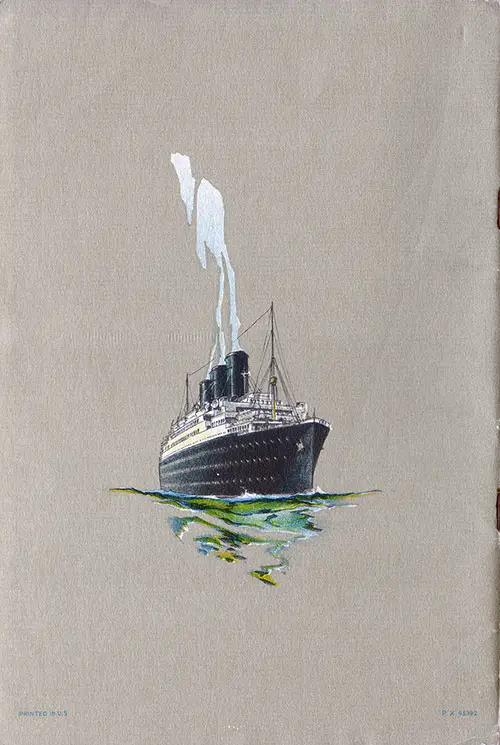
Back Cover, RMS Cameronia Passenger List, 3 July 1929. | GGA Image ID # 1e3fadc7ee
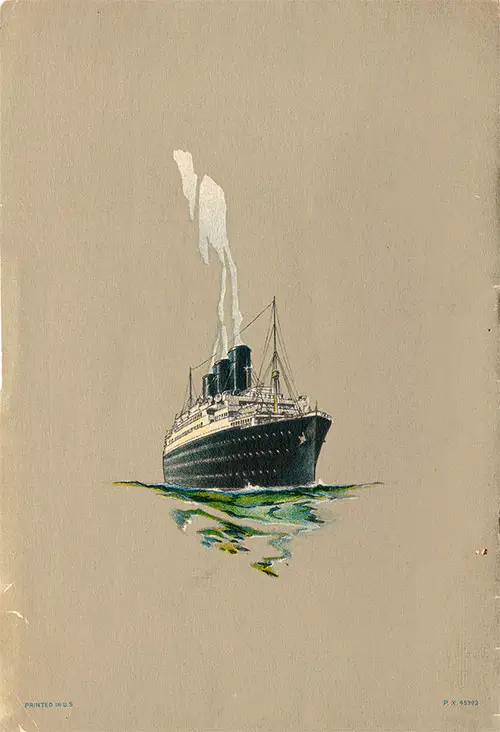
Back Cover, Anchor Line TSS Cameronia Cabin and Tourist Third Cabin Passenger List - 11 July 1931. | GGA Image ID # 1614f4ebc3

Back Cover, Anchor Line TSS Cameronia Cabin and Tourist Class Passenger List - 25 June 1932. | GGA Image ID # 1711910d54
Return to Content Links
Information for Passengers - 6 September 1913
SALOON
Meals will be served in the Saloon at the following times: Breakfast from 8 to 10: Luncheon at 1 p.m., and Dinner at 6:30. Supper, if required, will be served before 10 o'clock.
The Bar will be closed at 11 p.m. and the Smoke Room at 11:30 p.m.
The Chief Steward has the arrangement of the seats at the table.
Music Room Steward is provided with Telegraph Forms, Stamps, etc.
Telegrams and Letters for dispatch are to be handed to this Official (fully prepaid) one hour before leaving Moville. This Official will also provide Railway Time Tables for the use of Passengers.
Divine Service may be held (once) on Sunday,
Dogs: Passengers are notified that dogs can only be landed in Great Britain if a license has been previously procured from the Board of Agriculture, London. License forms can only be obtained by direct application to the department before the dog is taken on board. Dogs may be taken on specific dates and by special agreement only.
Baggage: All inquiries regarding baggage should be made to the Second Steward.
Trunks, Wraps, etc., will be received, stored, and shipped by the Company for the return voyage. The Second Steward will provide Passengers with Initial Labels for Boxes to facilitate baggage examination on landing.
Steamer Chairs may be hired from the Deck Steward at $1.00 for the voyage—printed receipt to be obtained by Passengers for this hire.
Valuables: The Company is not responsible for the loss of money or valuables. The Purser will be glad to place such in his safe if Passengers so desire. As no charge is made for carriage, the Company cannot accept any responsibility for loss or damage, however arising, but Passengers can protect themselves by Insurance.
Official Receipts: Passengers should obtain a receipt on the Company's form for any additional Passage Money or Freight paid on board.
Londonderry Passengers: Passengers joining Steamers for New York at Londonderry must be at our Office by 3 o'clock Afternoon on the day Steamers leave Glasgow.
Customs: Tobacco, cigars, etc. wines, spirits, and perfumery are liable to duty on being brought into the United Kingdom. The smallest quantities should be declared to the Customs authorities when required. Reprints of copyrighted books and music will be confiscated.
Surgeon.—Each Steamer carries an experienced Surgeon, who is authorized to make customary charges, subject to the approval of the Commander, for treating Saloon Passengers at their request for any illness not originating on board the ship. In the case of sickness contracted on board, no charge will be made, and medicine will be provided for free.
Source: SS Cameronia Passenger List - 6 September 1913
Information for Passengers - 24 February 1922
Additional Passage Money or Freight paid on board—Passengers should obtain a receipt on the Company's form for such disbursements.
Baggage.—Enquiries regarding baggage on board ship should be addressed to the Second Steward.
Trunks, Wraps, etc., will be stored and re-shipped by the Company for the return voyage.
To facilitate examination and identification of baggage on landing, all packages should have an official label affixed; these labels are supplied on board on application.
Baggage Insurance.—Passengers are recommended to insure their baggage, as, in the event of loss or damage, the Company cannot accept liability beyond the limit specified on the Steamer Contract Tickets. Rates and particulars on application.
Bar closes 11:00 pm
Barber's Shop.—Barber's shop is situated on board for the convenience of Passengers. The barber will attend to ladies by appointment.
Clothes Pressing.—Application should be made to the Barber, from whom rates and other particulars can be obtained.
Complaints.—Complaints of incivility, carelessness or inattention on the part of any of the ship's staff should be immediately reported to the Commander.
Confectionery and Souvenirs.—Confectionery and Souvenirs are on sale at reasonable prices on application to the Deck Steward.
Copyright Books and Music are forbidden and will be confiscated by the Customs authorities.
Deck Chairs and Rugs may be hired for the voyage at the Company's offices or from the Deck Steward. Printed receipt to be obtained by Passengers for this hire.
Divine Service may be held in the Saloon (weather permitting) once every Sunday between 11 and 12 noon.
Dogs.—Returning Passengers are notified that Dogs cannot be landed in Great Britain unless a licence has been procured from the Board of Agriculture, London. Forms of Licence can only be obtained by direct application to the Department before the dog is taken on board.
Dogs can only be carried by special arrangement being made with the Company prior to embarkation. Whilst on board they are not permitted in any of the public rooms or staterooms.
Drafts are issued, free of charge, payable in currency at any of the Offices of the Company in the United States and Canada, and, similarly, drafts are issued in the United States and Canada payable at any -of the Company's Offices in the United Kingdom in sterling, or at the Company's Offices in Europe in the currency of the country on which they are drawn.
Library.—Library Books may be obtained on application to the Deck Steward.
Lights in Saloon until n pm; in public rooms until 11:30 pm
Lifebelts—Lifebelts must not be removed from staterooms, except in cases of extreme danger and necessity.
Meals—Breakfast, 8:00 am to 10:00 am; Lunch, 1:00 pm; Dinner 7:30 pm
When two sittings are necessary, meals will be served as follows :-
- Breakfast, 8:00 am to 10:00 am;
- Lunch, First sitting, 12:30 pm; Second sitting, 1:30 pm
- Dinner, First sitting, 6:15 pm; Second sitting, 7:30 pm '
Passengers may reserve seats at table for the voyage on application to the chief steward. Meals cannot be served in cabins or on deck unless with the surgeon's permission.
Children's Meals—Breakfast, 9:00 am; Dinner, noon; Tea, 5:00 pm to 6:00 pm
Ports.—Passengers are requested not to open the ports. The Stewards will do this whenever practicable.
Railway Time-Tables may be consulted on application to the Music-Room Steward.
Smoking.—Smoking in saloons and state-rooms is strictly prohibited. Children are not allowed in the Smoke-room. Cigarette smokers are requested to be careful when smoking on deck to see that cigarettes are extinguished before being thrown away.
Storage.—The Company will undertake to store Deck Chairs and Steamer Trunks belonging to Passengers at owner's risk until they are required when returning. Chairs and Trunks should have owner's name painted on them, and they will not be re-shipped without instructions being sent to Baggage Master, Anchor Line, Yorkhill Quay, Glasgow, or in the case of Italian Ports, care of Anchor Line, Genoa, or Anchor Line, Naples. A description of the articles should be given, also name of steamer from which they were landed and date. No shawls, rugs, &c., to be attached to Chairs. No charge for storage is made if the owners return by the Company's vessels. If Chairs or Trunks are forwarded by rail this is done at owner's risk'and expense.
Table Seating.—The Chief Steward has the arrangement of table seating.
Telegrams and Letters for despatch should be handed to the Music-Room Steward (fully prepaid) one hour before leaving Moville.
Telegraph Forms and Postage Stamps can be had from the Writing-Room Stewards.
The Surgeon is authorized to make customary charges, subject to the approval of the Captain, for treating Saloon Passengers at their request for any illness not originating on board the ship. In the case of sickness contracted on board no charge will be made and medicine will be provided free.
Through Booking To Gibraltar, Egypt and India. —The Anchor Line steamers engaged in this service have excellent saloon accommodation. Full particulars as to Fares, etc., on application.
Tobacco, Spirits, Etc.—Tobacco, cigars, cigarettes,, wines, spirits and perfumery are liable to duty on being brought into the United Kingdom, and the smallest quantities should be declared to the Customs authorities.
Valuables.—Money or valuables should not be exposed in staterooms. The Company will not be responsible for articles lost or stolen. Valuables may be deposited in ship's safe, under care of the Purser, free of charge.
Passengers are warned that they should not on any account part with money or valuables to any persons representing themselves as members of the ship's staff.
Wines.—It is requested that Wines be ordered one hour before meals, so that they may be cooled ready for use.
Wireless Telegraphy.—Wireless Telegraph messages should be handed to the Purser for transmission.
Source: RMS Cameronia Passenger List - 24 February 1922
Information for Passengers - 11 July 1931
DISEMBARKATION ARRANGEMENTS AT LONDONDERRY— Passengers landing at Londonderry disembark by tender off Moville, whence they are taken to Londonderry—a distance of about 17 miles —the journey, by tender, taking about 1 and hours.
No passengers land at Moville; baggage is inspected at Londonderry. Moville is in the Irish Free State whereas Londonderry is in Northern Ireland.
The distance, by rail, from Londonderry to Belfast is 100 miles, and from Londonderry to Dublin 163 miles.
DISEMBARKATION AT GLASGOW—Passengers disembark either by tender at Greenock—which is on the River Clyde about 20 miles from Glasgow—or go up the river and disembark at Yorkhill pier, which is within easy reach of the principal railroad stations in Glasgow; passengers disembark at one or the other of the places mentioned according to the state of the tide, also the time of arrival of the steamer off Greenock. When passengers disembark at Greenock and customs formalities have been gone through, they are conveyed, free of charge, to Glasgow, either by a special or regular train; if the number of passengers does not warrant a special train, coaches are attached to a regular train for the convenience of Anchor Line Passengers.
SMOKING— Children are not allowed In the Smoke-room. Smokers are requested to be careful when smoking on deck to see that cigars, cigarettes and pipe ashes are extinguished before being thrown away.
THE DAILY MAIL ATLANTIC EDITION, giving the latest news by wireless and the closing prices on the London and New York Stock Exchanges, is published on board. The paper will be delivered each morning to the passenger's stateroom if an order is given to the Bedroom Steward.
Source: TSS Cameronia Passenger List - 11 July 1931
Information for Passengers - 25 June 1932
DIVINE SERVICE may be held in the Saloon (weather permitting:) once every Sunday between 11 and 12, for those who so desire facilities are provided for the celebration of Mass.
ADDITIONAL PASSAGE MONEY OR FREIGHT paid on board. Passengers should obtain a receipt on the Company's form.
WARDROBE TRUNKS—The passengers' attention is called to the fact that the steamer has a Baggage Room where trunks may be stored during the voyage. It is not always possible to have large wardrobe trunks placed in an accessible position in passengers' staterooms.
BAGGAGE—Enquiries regarding baggage on the ship should be addressed to the Baggage Master.
Trunks, Wraps, etc., may be stored and re-shipped by the Company for the return voyage.
To facilitate examination and identification of baggage on landing, all packages should have an initial label affixed; these labels are supplied on board on application.
BAGGAGE INSURANCE—Passengers are recommended to insure their baggage, as, in the event of loss or damage, the Company cannot accept liability beyond the limit specified on the Steamer Contract Tickets—rates and particulars on application.
BARBER'S SHOP—Barber's shop is on board for the convenience of passengers. The barber will attend to the ladies by appointment.
CLOTHES PRESSING—Application should be made to the barber, from whom rates and other particulars can be obtained.
COMPLAINTS—Complaints of incivility, carelessness, or inattention on the part of any of the ship's stalls should be immediately reported to the Purser or Chief Steward and, failing satisfaction, to the Captain.
THE BAR will be closed at 11 p.m.
KIOSK—Passengers can obtain confectionery, toys, souvenirs, novels, etc., in the Kiosk.
DECK CHAIRS AND RUGS may be hired at 0/3 (or $1.50) each on application to the Deck Steward. At the end of each voyage, the rugs which have been in use are sent to the store and thoroughly cleaned before being re-issued.
DRAFTS are issued, free of charge, payable in currency at any of the Offices of the Company in the United States and Canada, and. similarly, drafts are issued in the United States and Canada payable at any of the Company's Offices in the United Kingdom in sterling, or at the Company's Offices in Europe in the currency of the country on which they are drawn.
DOGS AND CATS—Passengers are notified that dogs and cats cannot be landed in Great Britain unless a license has been procured from the Board of Agriculture, London. License forms can only be obtained by direct application to the Department before the dog or cat is taken on board.
LIBRARY—Library Books may be obtained on application to the Librarian. The Books are issued free of charge.
MEALS—
- Breakfast, 8 to 10 a.m.;
- Lunch, 1 p.m.;
- Dinner, 7:30 p.m.
When two sittings are necessary, meals will be as follows:
- Breakfast, 8 to 10 a.m.;
- Lunch, 1st sitting, 12:30 p.m.; 2nd sitting. 1:30 p.m.
- Dinner, 1st sitting, 5:15 p.m. 2nd sitting, 7:30 p.m.
Passengers may reserve seats at a table for the voyage on application to the Chief Steward.
CHILDREN'S MEALS—Breakfast, 9 a.m.; Dinner, noon; Tea. 5 to 6 p.m.
PORT HOLES—Passengers are requested not to open the port holes. The Stewards will do this whenever practicable.
REDIRECTION OF MAIL—Passengers who expect letters or parcels to be delivered to the ship after disembarking should leave their full names and addresses at the Bureau so that their mail may be forwarded.
RETURN BOOKINGS—The Purser and his staff will always be pleased to assist passengers in arranging their return passages or supply them with the name and address of the agent in the town to which they are proceeding.
RAILWAY TIMETABLES—Railway and steamer timetables may be consulted on application to the Librarian.
DISEMBARKATION ARRANGEMENTS AT LONDONDERRY— Passengers landing at Londonderry disembark by tender off Moville, whence they are taken to Londonderry—a distance of about 17 miles —the Journey, by tender, taking about 1 and 1/2 hours.
No passengers land at Moville; baggage is inspected at Londonderry. Moville is in the Irish Free State, whereas Londonderry is in Northern Ireland.
The distance by rail from Londonderry to Belfast is 100 miles, and from Londonderry to Dublin, 163 miles.
DISEMBARKATION AT GLASGOW—Passengers disembark either by tender at Greenock—which is on the River Clyde about 20 miles from Glasgow—or go up the river and disembark at Yorkhill pier, which is within easy reach of the principal railroad stations in Glasgow: passengers disembark at one or the other of the places mentioned according to the state of the tide, also the time of arrival of the steamer off Greenock. When passengers disembark at Greenock and customs formalities have been gone through, they are conveyed, free of charge, to Glasgow, either by a special or regular train. If the number of passengers does not warrant a special train, coaches are attached to a regular train for the convenience of Anchor Line Passengers.
SMOKING—Children are not allowed in the Smoke-room. Smokers are requested to be careful when smoking on «leek to see that cigars, cigarettes, and pipe ashes are extinguished before being thrown away.
STORAGE—The Company will undertake to store Deck Chairs and Steamer Trunks belonging to passengers at the owner's risk until they are required when returning. Chairs and Trunks should have the owner's name painted on them. They will not be reshipped without instructions being sent to Luggage Master, Anchor Line, Yorkhill Quay, Glasgow. A description of the articles should be given, the name of the steamer from which they landed and the date. No shawls, rugs, etc., are to be attached to Chairs. No charge for storage is made if the owners return by the Company's vessels. If Chairs or Trunks are forwarded by rail, this is done at the owner's risk and expense.
THE SURGEON is authorized to make customary charges for his service subject to the approval of the Commander to First Class. Cabin. Second Class and Tourist Third Cabin passengers.
TORACCO, SPIRITS, etc.—Tobacco, cigars, cigarettes, wines, spirits, and perfumery are liable to duty on being brought into the United Kingdom. Even the smallest quantities should be declared to the Customs authorities.
THE DAILY MAIL ATLANTIC EDITION is published on board, giving the latest news by wireless and the closing prices on the Loudon and New York Stock Exchanges. The paper will be delivered each morning to the passenger's stateroom if an order is given to the Bedroom Steward.
Source: TSS Cameronia Passenger List - 25 June 1932
Return to Content Links
The Anchor Liner Cameronia - 1921
The first of a fleet of five new steamers arrives in New York.
THE new Anchor Line oil-burner Cameronia, with a large list of passengers, arrived in New York last week on her maiden voyage from Liverpool via Queenstown and Halifax. After this trip to New York, she will sail on the regular Anchor Line service between New York and Glasgow via Londonderry.
The Cameronia is the first of a fleet of five new Anchor liners, the others now rapidly nearly completion being the Caledonia, California, Tuscania and Transylvania. Each of the quintet will be of 16,700 tons and will be oil-burners.
Owing to the compact manner in which oil fuel can be carried and the fact that but one funnel will protrude through the decks, these steamers will be equal in size—as far as accommodations are concerned—to coal burning ships of from 20,000 to 25,000 tons.
The Anchor Line lost seven steamers through enemy action during the war. The new fleet will more than replace the tonnage lost.
The Cameronia was launched from the yard of Messrs. Wm. Beardmore and Company, Limited, Dalmuir, Scotland, on the 23rd of December, 1919, and, as a fitting tribute to the gallant vessels which were lost during the war, her name has been passed on to her in memory of the Cameronia which was launched on the 27th of May, 1911, the christening ceremony on each occasion being performed by Lady Hermoine Cameron of Lochiel.
In external appearance the Cameronia is a striking vessel, with a straight stem and cruiser stern. She has two steel pole masts and a well-proportioned funnel, elliptical in shape and with Admiralty top. Her paintwork is the well-known color combination of the Anchor Line—black hull and funnel and white superstructure.
Her principal dimensions are: 571 feet 6 inches in length overall, 70 feet molded breadth, and 42 feet 9 inches molded depth. Her gross tonnage is 16,700 tons, and when fully loaded her displacement is 23.500 tons. She will comfortably carry about 1,800 passengers.
Her engines are of two sets of Brown-Curtiss double reduction geared turbines, a method of driving that simplifies a most important problem for the engineers, as it permits the operation of both turbines and propellers at their respective natural and economic speeds; for the passenger it means that vibration is reduced to a minimum.
Steam for the turbines is generated by three double ended and three single ended boilers working at a pressure of 220 pounds per square inch. At the time of her launching the Cameronia was the first oil-burning steamer designed to enter the Glasgow and New York route.
For the auxiliary machinery on deck new methods have been adopted, all winches, windlasses, and capstans being operated by electricity instead of steam, while the steam steering gear is controlled by telemotor and fitted with a liquid-controlling brake to avoid jarring and straining.
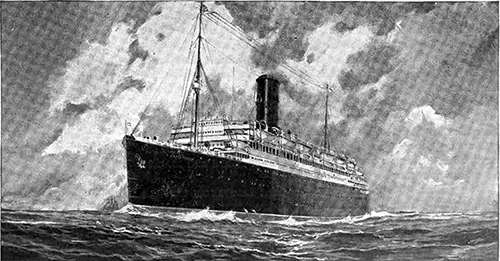
The new Anchor liner Cameronia arrived in New York last week. She is a striking looking ship, with a straight stem and cruiser stern. She is the first of five sister ships building for the Anchor line, and is 571 feet long, 70 feet beam and 16,700 gross tons. | GGA Image ID # 1421e17301
The passenger accommodation is thoroughly modern and is distributed over no fewer than six decks, these being "A" (bridge deck), "B" (shelter deck), "C" (upper deck), "D" (main deck), "E" (lower deck), and "F" (orlop deck); while above all is the boat deck. First and second class passenger accommodation is located amidships, most of the staterooms being on "B" and "C" decks, and arranged for one, two or three passengers in each.
The first-class dining saloon is situated on "D" deck, while the other public rooms for first class passengers are all situated on "A" deck, and include writing room, lounge, gymnasium, smoking room, and verandah cafe.
The second class accommodation is to a large extent arranged separately on the same decks as the first class, the staterooms being designed for two and four occupants each, with a few large cabins for families; the public rooms provided being a dining saloon, music room, and smoke room.
The steamers of the Anchor Line have always been favorites with third class passengers, and on the Cameronia special attention has been given by the Company to their requirements. On "C", "D", and "E" decks, accommodation has been provided for 1,100 passengers in this class in rooms containing two, four, and not more than six passengers each. The dining saloons on "D" deck are designed to seat 500 passengers, while on "C" deck are found the smoking room and general room.
The various kitchens are airy and large and fitted with every modern appliance, while the cold storage chambers are so designed that fish, vegetables, fruit, and meat are separately stored, the refrigerating machinery not only keeping these compartments at the required temperature, but in addition providing the large quantities of ice which are daily required throughout the voyage.
As in all modern liners, the Cameronia is fitted with a complete installation of long distance wireless telegraphy which is at the disposal of passengers by day and night.
"The Anchor Liner Cameronia," in Shipping, Marine Transportation, Construction, Equipment, and Supplies, New York: Shipping Publishing Company, Inc., Vol. XIII, No,. 10, 25 May 1921, p. 15.
Return to Content Links
